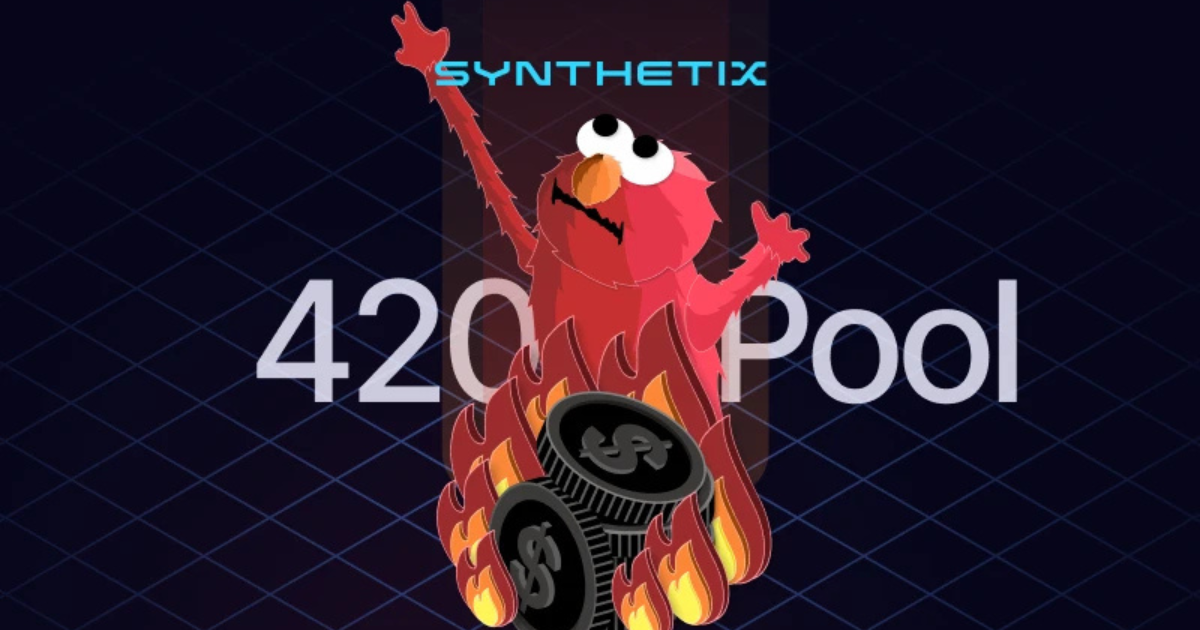The struggling stablecoin of Synthetix has been addressed by a new liquidity initiative. After sUSD weakened significantly below par, the company launched the sUSD 420 Pool on April 18. This is part of a broad plan to stabilize the algorithmic stablecoin under challenging market conditions.
Key-Takeaways:
- The sUSD 420 Pool was launched to stabilize Synthetix’s stablecoin (sUSD), which reached as low as $0.63, through rewarding 5 million SNX tokens over 12 months.
- In SIP 420, the collateralization requirements were reduced from 500% to 200%, thus resulting in too much sUSD supply.
- The SNX rewards are paid daily, and the amounts vest over 3 months after the program ends for participants who are ready to lock their sUSD for 1 year.
- Additional initiatives beyond the 420 Pool: Synthetix is planning to launch the Snaxchain project to present more use cases for sUSD.
The Depeg Problem
 In recent weeks, the sUSD stablecoin has not been stable. But CoinGecko data puts sUSD at $0.8224 as of April 18, down from $0.63 (or down to $0.12 since entering the crvswap pool). Still, it had a steady 7% increase over 24 hours in the token. This has concerned investors and users of the Synthetix platform who are worried about the price decline.
In recent weeks, the sUSD stablecoin has not been stable. But CoinGecko data puts sUSD at $0.8224 as of April 18, down from $0.63 (or down to $0.12 since entering the crvswap pool). Still, it had a steady 7% increase over 24 hours in the token. This has concerned investors and users of the Synthetix platform who are worried about the price decline.
These issues prompted founder Kain Warwick to announce the new pool on X (formerly Twitter) himself. Over a 12-month period, SNX tokens will be distributed to participants in the initiative, of which 5 million will be distributed. This generous reward structure is intended to encourage people’s demand for sUSD and build back its dollar peg.
Root Causes of Instability
 These problems are a consequence of changes introduced in recent months in the form of Synthetix Improvement Proposal 420. The problem with this controversial update was reduced collateralization requirements and protocol-owned staking pools. Previously, users would need to put up 500% collateral should they wish to mint sUSD tokens. All that remains for them now is to supply 200%.
These problems are a consequence of changes introduced in recent months in the form of Synthetix Improvement Proposal 420. The problem with this controversial update was reduced collateralization requirements and protocol-owned staking pools. Previously, users would need to put up 500% collateral should they wish to mint sUSD tokens. All that remains for them now is to supply 200%.
This constituted a fast increase in sUSD’s supply. Unfortunately, however, this growing supply has not so easily matched demand. Therefore, many of the decentralized exchange pools were unbalanced. sUSD is now over 90% of some liquidity pairs on Curve (a popular DEX platform).
How the 420 Pool Works
 The new initiative requires commitment of the participants. To earn rewards on SNX, sUSD tokens must be locked for a year. And in return they get SNX distributed on a daily basis. However, these reward tokens are not available immediately. Over three months after the program ends, they remain locked and are vested to be taken over in time.
The new initiative requires commitment of the participants. To earn rewards on SNX, sUSD tokens must be locked for a year. And in return they get SNX distributed on a daily basis. However, these reward tokens are not available immediately. Over three months after the program ends, they remain locked and are vested to be taken over in time.
The front-end support won’t be officially launched next week, but early adopters are already part of it. Synthetix has made early access available to their Discord community. A phased approach to this enables the team to monitor participation and adjust if needed.
Synthetix describes the current situation as a “transition period” for the protocol. The 420 Pool is not the only stablecoin solution on which the team has been relying. In the next few months, more incentives and new use cases for sUSD will be implemented by them.
An initiative that is promising on the horizon is Snaxchain. Despite limited details for now, a new stablecoin project on the horizon may find new utility for the struggling stablecoin. In other words, Synthetix wants to add more reasons for users to keep and use sUSD organically, thereby increasing demand.
Conclusion: sUSD 420 Pool
As a result, the success or failure of the sUSD 420 Pool could affect a larger group. The current state of affairs is holding risk and opportunity for traders and investors. Arbitrage traders may come in seeking to profit on the peg ultimately recovering, which would offer the sUSD trading at a discounted price. Additionally, the high SNX rewards might be attractive to long-term supporters ready to lock up capital.











